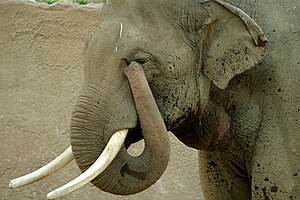Nose: Difference between revisions
imported>Nancy Sculerati MD No edit summary |
imported>Nancy Sculerati MD (added outline corrections) |
||
| Line 1: | Line 1: | ||
{{otheruses}} | {{otheruses}} | ||
The nose is the portion of the airway used | The nose is the portion of the airway preferentially used for inhalation, and usually contains sense receptors for the [[sense of smell]] ([[olfaction]]). All newborn human babies breathe through the nose, and are called therefore called "obligate nasal breathers". Crying newborns sometimes breathe in through the mouth, and many adults are mouth-breathers. Inhalation through the mouth is generally either a learned habit, or performed because of nasal obstruction to airflow. | ||
In humans, the nose is located centrally on the face; on most other [[mammal]]s, and in reptiles and amphibians, it is on the upper tip of the snout. | |||
The nose acts an interface between air within the body's respiratory passages and the atmosphere of the external world. The nose and associated structures (the paranasal sinuses) frequently perform additional functions concerned with conditioning entering air (for instance, by warming and/or humidifying it) and by mostly reclaiming moisture from the air before it is exhaled (as occurs most efficiently in [[camel]]s). | |||
In most mammals, the nose is the primary organ for [[olfaction|smelling]]. As the animal sniffs, the air flows through the nose and over structures called [[turbinate]]s in the [[nasal cavity]]. The turbulence caused by this disruption slows the air and directs it toward the [[olfactory epithelium]]. At the surface of the olfactory epithelium, [[odor]] molecules carried by the air contact [[olfactory receptor neuron]]s. which transduce the features of the molecule into electrical impulses in the [[brain]]. | In most mammals, the nose is the primary organ for [[olfaction|smelling]]. As the animal sniffs, the air flows through the nose and over structures called [[turbinate]]s in the [[nasal cavity]]. The turbulence caused by this disruption slows the air and directs it toward the [[olfactory epithelium]]. At the surface of the olfactory epithelium, [[odor]] molecules carried by the air contact [[olfactory receptor neuron]]s. which transduce the features of the molecule into electrical impulses in the [[brain]]. | ||
| Line 16: | Line 14: | ||
==Human nose== | ==Human nose== | ||
==External Nose== | |||
===Shapes of the human nose=== | ===Shapes of the human nose=== | ||
===Nasal Trauma (Broken Nose)=== | |||
==Internal Nose== | |||
===The nasal airway=== | |||
===The nasal mucosa=== | |||
===The nasal septum=== | |||
==Culture== | ==Culture== | ||
Revision as of 13:18, 2 November 2006
The nose is the portion of the airway preferentially used for inhalation, and usually contains sense receptors for the sense of smell (olfaction). All newborn human babies breathe through the nose, and are called therefore called "obligate nasal breathers". Crying newborns sometimes breathe in through the mouth, and many adults are mouth-breathers. Inhalation through the mouth is generally either a learned habit, or performed because of nasal obstruction to airflow.
In humans, the nose is located centrally on the face; on most other mammals, and in reptiles and amphibians, it is on the upper tip of the snout.
The nose acts an interface between air within the body's respiratory passages and the atmosphere of the external world. The nose and associated structures (the paranasal sinuses) frequently perform additional functions concerned with conditioning entering air (for instance, by warming and/or humidifying it) and by mostly reclaiming moisture from the air before it is exhaled (as occurs most efficiently in camels).
In most mammals, the nose is the primary organ for smelling. As the animal sniffs, the air flows through the nose and over structures called turbinates in the nasal cavity. The turbulence caused by this disruption slows the air and directs it toward the olfactory epithelium. At the surface of the olfactory epithelium, odor molecules carried by the air contact olfactory receptor neurons. which transduce the features of the molecule into electrical impulses in the brain.
In cetaceans, the nose has been reduced to the nostrils, which have migrated to the top of the head, producing a more streamlined body shape and the ability to breathe while mostly submerged. Conversely, the elephant's nose has become elaborated into a long, muscular, manipulative organ called the trunk.
Human nose
External Nose
Shapes of the human nose
Nasal Trauma (Broken Nose)
Internal Nose
The nasal airway
The nasal mucosa
The nasal septum
Culture
Some people choose to get rhinoplasty to change the aesthetic appearance of their nose. Nose piercings are also common, such as nostril, septum or bridge.
In New Zealand, nose pressing ("hongi") is a traditional greeting.
People famous for their noses
- Cyrano de Bergerac
- Jimmy Durante
- W.C. Fields
- Major Kovatzov in Nikolai Gogol's novel The Nose.
- Michael Jackson
- Karl Malden
- Jack Nicholson in the film Chinatown (1974) by Roman Polanski
- Barbra Streisand
References
- Physical Manual: Univ. of Tennessee at Martin
- Eden Warwick (pseudonym of George Jabet), Nasology, or hints towards a classification of Noses, London, Richard Bentley, 1848
- Encyclopedia Britannica Micropedia, 1982
See also
- Empty nose syndrome
- hooknose
- WikiSaurus:nose — the WikiSaurus list of synonyms and slang words for the nose in many languages
- sneeze
- photic sneeze reflex
- nose-picking
- nosebleed
- Little's area
- olfactory system
- mucus
- rhinoplasty
- Jala neti
- Sròn
External links
- WebMD: The Sinuses and The Nose
- From the Nose to the Eustachian Tube: Information, videos, tips for diving
- Your Nose: The Guardian Of Your Lungs
- Asian Noses This website discusses the differences in Asian noses.
- The Empty nose syndrome patient association
Template:Respiratory system Template:Human anatomical features
ar:أنف ca:Nas cs:Nos cy:Trwyn da:Næse de:Nase (Organ) et:Nina es:Nariz eo:Nazo fr:Nez ko:코 io:Nazo it:Naso (anatomia) he:אף lv:Deguns lt:Nosis mk:Нос nl:Neus ja:鼻 no:Nese pl:Nos pt:Nariz ru:Нос sq:Hunda simple:Nose sk:Nos sl:Nos fi:Nenä sv:Näsa tr:Burun (organ) zh-yue:鼻 zh:鼻
